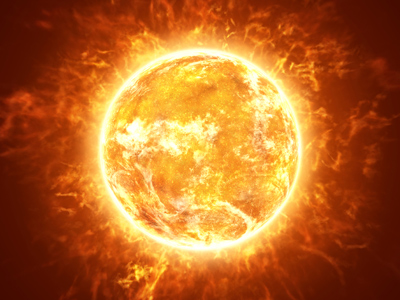Infrared (sometimes written infra-red or infra red) radiation was discovered by the famous astronomer, William Herschel. As happens quite often in scientific discoveries, it came from noticing something unexpected, asking questions and then carrying out more tests in order to try to find answers. In this case, he had been observing the Sun.
Looking at the Sun directly is dangerous to the eye, especially through a telescope. He had been using different dark glass filters to protect his eyes during observations and noticed that some let through different amounts of light and others let through different amounts of heat. So he took this further and measured the temperature increase in different parts of a visible spectrum using thermometers.
He found the greatest increase in the red part of the spectrum but as the Sun moved across the sky, he noticed that the temperature became even higher when the thermometer was just beyond the end of the red part of his spectrum. Further experimentation showed the heating decreased further away from the spectrum and that there was no heating effect beyond the violet.
We now know infrared is part of the electromagnetic spectrum and that all objects emit (give out) and absorb this thermal radiation. The hotter an object is, the more infrared it emits. But temperature is not the only factor, the type of surface affects how much heat radiation is emitted or absorbed. Dark matt surfaces are better at doing both, whilst light-coloured highly-polished surfaces absorb and emit the least. Houses in hot countries are often painted white, to reflect the Sun's infrared radiation which helps to keep them cooler. Solar panels for heating water have matt black surfaces in order to absorb as much infrared radiation as possible. They are so efficient that they still work on cloudy days - but obviously not as well as on sunny days.
Infrared radiation is one of three ways in which heat can travel. Since infrared is an electromagnetic wave, it does not require a material medium through which to travel (conduction needs a solid medium and convection requires a liquid or a gaseous medium) and can travel through solids, liquids, gasses and a vacuum. Since space is a vacuum, it is the only way that heat from the Sun can reach the Earth. Provided the medium is transparent to infrared radiation wavelengths, it can pass through.
Infrared is incredibly useful - it is used in night vision goggles, police helicopter cameras (to find suspects hiding in gardens, woods and at night), security lights have sensors that switch them on by detecting the heat from people who are near to them and of course it is used for TV remote controls. For astronomers, it is great as it can pass through interstellar dust and gas clouds, allowing them to see through to objects hidden on the other side.








